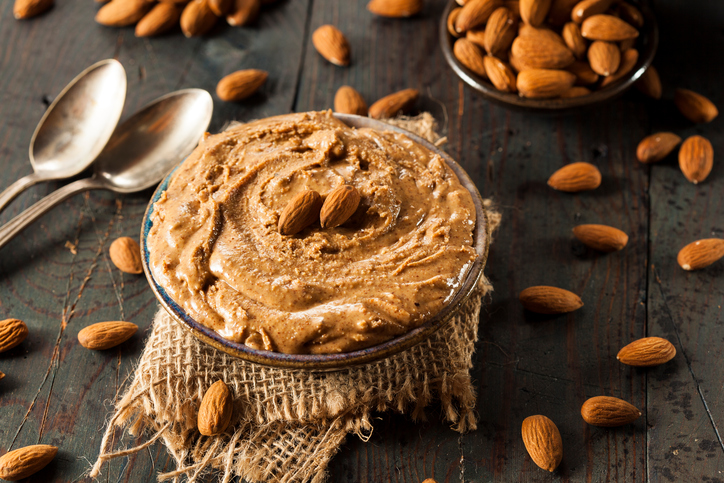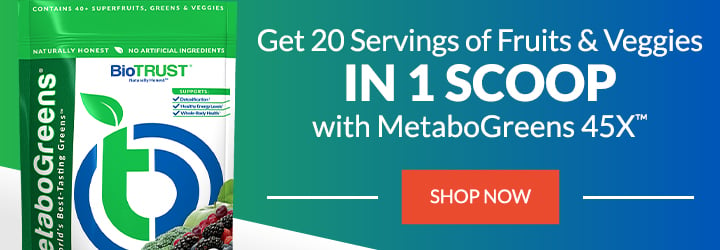Almond Butter vs Peanut Butter — What’s Best for Dropping Fat?

Q: I love peanut butter. I regularly add it to my BioTrust Low-Carb shakes for a decadent yet healthy treat. But someone at the gym just told me I should avoid peanut butter like the plague if I want to drop fat. (I do.) Do I have to give up my peanut butter completely? Should I switch to almond butter instead? Are there any good choices of nut betters?
I’m missing my peanut butter already.
-Robert
A: Thanks for your question, Robert! I can’t tell you how many times I’ve been asked whether or not nut/seed butters can be part of a healthful nutrition plan. The short answer is:
Absolutely!
Are you breathing a sigh of relief? Me too! I love my nut butters and would hate to give them up for good
Nut butters, quite simply, are delicious, convenient, and generally contain high concentrations of monounsaturated fatty acids, vitamins, minerals, antioxidants, and polyphenols, which may help fight inflammation. But, let’s address your question on almond butter vs peanut butter.
Almond Butter vs Peanut Butter
First and foremost, I think it’s important to highlight that variability in one’s diet is important. In other words, I believe one should vary their nutrition plan to obtain all the micronutrients and phytonutrients possible. Under this assertion, both almonds and peanuts fit into a wholesome and nutritious diet. Neither is necessarily better than the other; they’re just different. Overall, I’m all for eating tree nuts, seeds, and peanuts. If you consume them raw or lightly roasted, then that would be ideal.
From a calorie and macronutrient standpoint, almonds and peanuts don’t differ too much. They both are high in monounsaturated fats and have a decent amount of protein per ounce/serving. Thus, they’re both pretty darn good options if you’re looking to increase your nut consumption (although peanuts are technically a legume/grain). That being said, peanuts are one of the most common food allergies, so I think there is a trend in the food industry to recommend almonds over peanuts. Furthermore, some Paleo diet advocates advise against eating legumes/grains, so peanuts are not acceptable foodstuffs for many who follow a strict Paleo diet.
Thus, the real question isn’t almond butter vs peanut butter. But rather, which nut/seed butter brands are better for your nutrition plan, and how do you figure out how much to consume?
How to Find the Right Brand?
I like to use a good > better > best continuum (GBB-continuum) when looking at food consumption. That is, I always aim to consume the “best” foods when the opportunity presents itself; however, I realize it’s not always possible to do so, and this is where “better” and “good” foods come into play. Here is how I go about purchasing nut/seed butters based on the GBB-continuum.
• Does it contain only raw ingredients? The majority of manufacturers like to roast their nuts/seeds, which is generally an acceptable practice. However—more often than not—the roasting process calls for the use of additional oils like canola, peanut, safflower, etc. Since we’re shooting for optimal here, try your best to shop for raw nut/seed butters.
• Is it organic? While there is still debate on whether or not organic foods are always better, I believe it’s always best to err on the side of caution.
You see, we know pesticide consumption and exposure is harmful beyond a reasonable doubt, but the degree to which we are exposed to these agricultural methods is somewhat unclear. Thus, it makes sense to limit our potential for exposure by opting for organically-grown foods, and in this case, nuts/seeds.
• Is it unsweetened? This is pretty self-explanatory. Avoid any product with added sugars, artificial sweeteners, or even more healthful sweeteners like unrefined honey and maple syrup.
With that said, if you’re following specific macronutrient guidelines and/or having a Cheat Day, then it may warrant the consumption of a nut/seed butter with extra carbohydrates, in which case unrefined honey and maple syrup would be acceptable.
The Good > Better > Best Continuum in Practice:
Good: Natural Nut Butter (roasted almonds or peanuts, palm oil, salt, sugar)
Better: Natural Nut Butter (raw nuts, salt)
Best: Organic Nut Butter (organic raw nuts)
Caveats: Always avoid any nut/seed butter that contains hydrogenated oils (i.e., trans fatty acid-containing oils), as they’ve been shown time and time again to be a risk factor for the development of cardiovascular disease. As a matter of fact, consuming just 2% of daily calories from trans fatty acids, which equates to only about 4.5 grams of fat, has been associated with a 23% increase in cardiovascular risk. The American Heart Association, and every other authority on health and nutrition, recommends limiting—or completely eliminating—trans fat intake to less than 1% of total calories per day.
How Much Can I Eat?
This is highly dependent on your goals, level of body composition, caloric intake, general meal composition, and overall diet. Simply put, there is not a one-size-fits-all approach to eating, nor is there one for consuming nut/seed butters.
With that said, if you are following any of the BioTrust-approved diet protocols, it’s safe to assume you may include 1 to 1.5 tablespoons of nut/seed butter in any meal requiring a fat source.
For those not following a specific diet, you’ll need to figure out the best way to include nut/seed butters into your plan, which I’d be happy to help you with.
Almond Butter vs Peanut Butter — The Wrap Up
Generally speaking, most foods can be eaten in moderation. Keeping that in mind, we need to look at food consumption as a whole. When we start looking at individual foods or meals in a vacuum (like almond butter vs peanut butter), it makes dieting and eating that much more difficult. So the only nut butters you should make sure you eliminate are those that have been tainted by adding hydrogenated fats.
Enjoy your nut/seed butters, ladies and gentlemen!
-Coach Cristina







